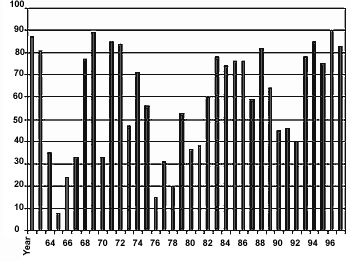| Home | About Us | Resources | Archive | Free Reports | Market Window |
Your Mutual Fund Is Swindling YouBy
Thursday, October 18, 2007
It's perverse. Mutual-fund customers would do much better, on average, if they'd sell their funds and buy the fund owner. They would earn management fees instead of paying them. Take Janus Capital (JNS) for example. It's one of the largest mutual fund managers in America. I recommended Janus to Extreme Value readers about three years ago. Folks who bought back then are now up 120%, and more if they bought every time we re-recommended it. Back in July 2004, Janus Capital's assets under management had fallen from their bubble peak of more than $300 billion, to less than half that, around $130 billion. Today, they're just under $190 billion, up nicely over the last few years. Why is Janus doing so well? What's the big attraction? Well, Janus' business has always done well, if by well we mean low capital requirements and ample cash flows. The business has always done well because there's no shortage of mutual-fund buyers out there. Why so many people love actively managed mutual funds, I will never know. Most funds can't even deliver so-called "market returns," as measured by indexes. And the indexes are too actively managed, so they perform poorly over time. Let me help you think about this. Below is a famous chart from John Bogle's book, Common Sense on Mutual Funds. It shows you the percentage of general equity funds that were outperformed by the S&P 500 index between 1963 and 1998. As you can clearly see, in 22 out of 36 years, more than half the general equity funds Bogle studied didn't do as well as the S&P 500 index. This chart in particular, and Bogle's work in general, is the source of the common – and correct – assertion that most mutual funds don't beat the market.
But even though the performance stinks, mutual-fund managers still earn plenty. Bogle says that a hypothetical investor who puts in $10,000 and waits 50 years makes $1.17 million at 10% a year. But... the investor turns over about $700,000 of that to the fund industry in fees, and keeps a paltry $470,000 for himself. It's perverse, but there's an easy solution for you: Get on the other side of the mutual-fund game and collect fees, instead of paying them. That's what buying shares of Janus Capital, or any other big mutual-fund company, gets you. Compared to the capital that goes into the money-management business (a few bucks for rent and utilities), the compensation is outrageous. On tangible capital of about $565 million, Janus generated free cash flow of $284 million in 2006, a return on capital of 50%. Wow. Over time, Janus' dozens and dozens of mutual funds should just about match the market's performance... or maybe do a little worse. Either way, as crazy as it seems, Janus will to continue to see revenue of about 1% of assets under management, even if its funds don't do so hot and even if times get really tough. Plenty of Janus funds did lousy when the tech boom crashed starting in 2000. That year, Janus' revenues exceeded $2.2 billion and the company brought in more than $600 million in free cash flow. In fact, the business is profitable every year, and has reliably cranked out free cash flow each year (with the exception of 2004, when repayment of long-term debt consumed cash). It's used that cash to buy back about 25% of its shares over the last three years. Of course, like I said above, Janus is up about 120% since I recommended it to my readers. And it's trading at a high multiple of cash flow right now. So I wouldn't initiate a new position in Janus. But you should know that your mutual funds are making more money off of you than you are off of them. You can turn that unfortunate circumstance around if you buy shares of your favorite publicly traded money manager when the price is right, and simply hold for the long term. Good investing, Dan Ferris
Further Reading:
Market NotesINTEL SAYS WE'RE STILL BUYING COMPUTERS
Longtime DailyWealth readers will recall that we prefer to use government economic reports as kindling rather than make any real decisions with them. Give us the real world. Give us the price of copper, the share price of Cummins, and give us the Dow Jones Transportation Average. Then we'll know how healthy the world economy is. For the past few years, we've written about how these indicators screamed "full speed ahead." Today we add the stock chart of Intel to the DailyWealth toolbox. Yesterday, the world’s largest microprocessor maker reported a blowout third quarter. Revenue climbed 15% and net income climbed 43%. As Cummins is to all things construction, Intel is to all things tech. You're probably using their products right now. Our colleague Porter Stansberry wrote up the full Intel story, which you can read here. Don't get us wrong… we're not cheerleading the economy. But Intel's strong quarter and today's chart tell us that global demand for computers, gadgets, and electronics is robust. The bears will have to wait a while longer before their long expected global meltdown. |
Recent Articles
|


